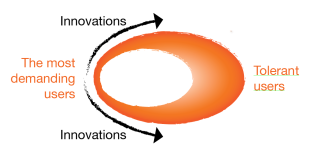Design for All
Design for All is a vision of a world where we see the benefit of diversity - a world in which everyone can participate and contribute - a world where we care for each other and nature.

Traditional design process
On the right side of the oval, we have the largest group: people without any specific needs or limitations. As we move further to the left, the demands on a product increase, driven by either professional requirements or physical impairments.
In traditional design processes, development often begins with an existing product, focusing primarily on users without special needs. Designers then make incremental adjustments, perhaps considering that the user might be slightly weaker or less able. However, this approach typically leads to minimal improvements—a simple "redesign" of existing products rather than a truly inclusive solution.

Design for All process
The Design for All approach often sparks true innovation. The key difference is that we begin with the needs of the most demanding users, rather than tweaking existing solutions. By identifying the core problem these solutions aim to address and understanding who the users truly are, we actively involve them throughout the design process—co-creating, refining, and testing sketches, models, and prototypes together.
Because we shape the final design to meet genuine human needs and desires, the connection between the user and the product becomes deeply ingrained. This strong relationship significantly reduces the tendency for "wear and tear" behavior, as user satisfaction is inherently built into the design.